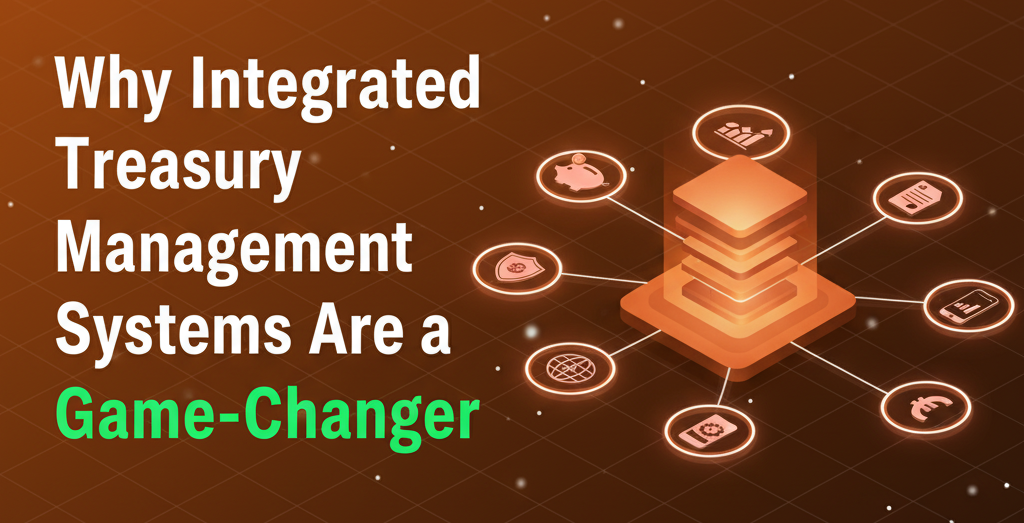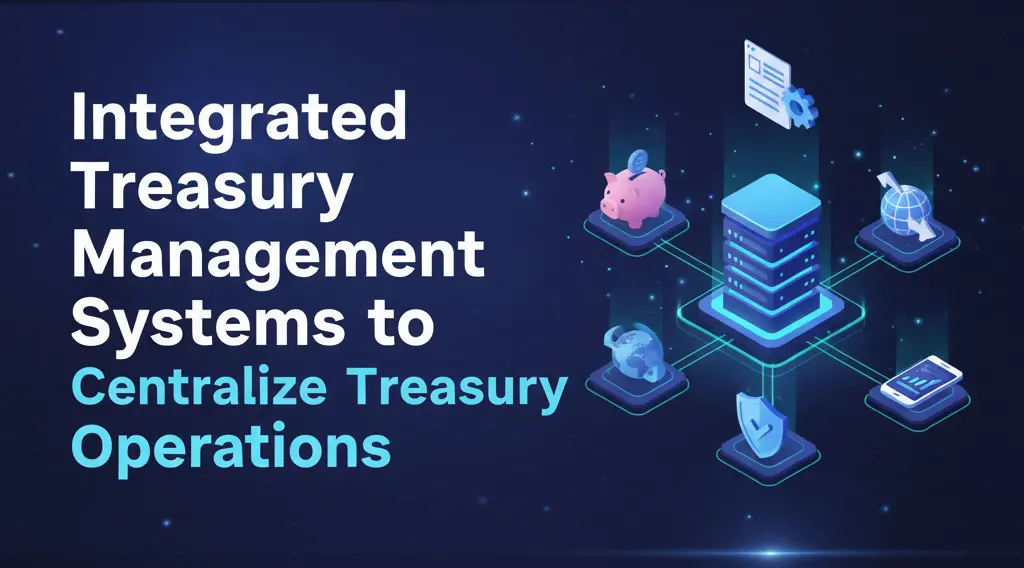Why Integrated Treasury Management Systems Are a Game-Changer
In today’s fast-moving financial landscape, businesses are constantly searching for ways to improve efficiency, reduce risks, and gain better visibility over their cash and liquidity. One of the most transformative tools helping companies achieve this is the Integrated Treasury Management System (TMS). Whether it’s managing payments, forecasting cash flows, or ensuring compliance, these systems have changed how modern finance teams operate.

Let’s dive into why Integrated Treasury Management Systems are considered a true game-changer and how they’re shaping the future of financial management.
What is an Integrated Treasury Management System?
An Integrated Treasury Management System (TMS) is a centralized software platform designed to manage a company’s financial assets, cash flow, liquidity, investments, and risks. Unlike traditional or standalone tools, an integrated TMS connects all treasury functions under one system.
It provides seamless connectivity between departments such as accounting, payments, reconciliation, risk management, and reporting. This means that all financial data flows into a single, unified platform instead of being scattered across multiple systems.
In simple terms, it gives finance teams one source of truth for all treasury operations.
How Treasury Operations Worked Before Integration
Before integrated systems came into play, treasury teams had to deal with fragmented tools and manual processes. Spreadsheets, disconnected accounting systems, and delayed bank statements were part of daily operations.
This led to:
- Data duplication and entry errors
- Limited real-time visibility of cash positions
- Difficulty in managing multiple bank relationships
- Delays in decision-making
- High operational costs
These inefficiencies made treasury management more reactive than strategic. Finance teams often spent more time gathering and verifying data instead of analyzing it or planning ahead.
The Shift Toward Integration in Treasury Management
As businesses grew more complex and globalized, the need for real-time visibility and control increased. Companies began looking for systems that could bring all treasury functions under one roof.
An integrated TMS fulfills this need by connecting directly to banks, ERPs, and other financial systems. It provides automatic data updates, real-time reporting, and process automation.
This shift toward integration isn’t just about technology—it’s about transforming how finance operates. It helps treasury teams move from manual data collection to strategic decision-making.
Key Features of an Integrated Treasury Management System
To understand why integrated TMS solutions are revolutionary, let’s look at the key features that make them powerful.
1. Real-Time Cash Visibility
An integrated TMS provides a consolidated view of a company’s cash positions across all bank accounts and subsidiaries. This allows treasurers to make faster and more accurate decisions about funding, borrowing, and investments.
2. Automated Bank Reconciliation
Reconciliation is one of the most time-consuming treasury tasks. Integrated systems automate this process by matching transactions between internal records and bank data in seconds. This improves accuracy and reduces manual workload.
3. Centralized Payment Management
Managing payments across multiple banks and regions can be complex. With an integrated system, all payments are centralized, standardized, and easily tracked. It also enhances security through built-in controls and approval workflows.
4. Liquidity and Cash Flow Forecasting
Integrated treasury systems use real-time data to forecast cash flow accurately. They provide insights into future liquidity needs, helping companies plan for short-term and long-term financing.
5. Risk and Compliance Management
Integrated systems come equipped with tools for FX risk management, interest rate monitoring, and regulatory compliance. They ensure that every transaction adheres to internal policies and global financial regulations.
6. Reporting and Analytics
Advanced analytics and dashboards give treasurers actionable insights. Customizable reports make it easier to track performance, monitor cash positions, and analyze trends.
Why Integration Changes Everything
The real power of an integrated TMS lies in its connectivity. Integration allows the treasury to communicate seamlessly with banks, ERP systems, accounting tools, and even payment gateways.
Here’s how integration transforms treasury operations:
1. Unified Data View
Instead of juggling multiple systems, treasurers have one dashboard that shows a real-time view of all transactions, balances, and exposures. This improves transparency and reduces confusion.
2. Greater Efficiency
By automating repetitive tasks such as bank reconciliation and payment approvals, an integrated TMS saves hours of manual effort. Teams can focus on strategy instead of administration.
3. Reduced Errors
When data flows automatically between connected systems, there’s less room for human error. This enhances accuracy and ensures that reports are always reliable.
4. Improved Decision-Making
Real-time data and analytics empower decision-makers with instant insights. Whether it’s making an investment or planning liquidity, finance leaders can act faster with confidence.
5. Cost Reduction
Integration reduces operational costs by eliminating redundant systems and manual processes. It also improves resource utilization across departments.
The Strategic Advantages for Businesses
An integrated treasury management system doesn’t just make finance efficient—it adds strategic value across the organization.
1. Enhanced Cash Control
With real-time visibility, companies can ensure that every dollar is accounted for. They can identify idle cash, optimize working capital, and improve overall cash utilization.
2. Better Collaboration Across Teams
Integration brings accounting, finance, and operations together. When everyone works from the same data, collaboration becomes easier and decisions more aligned.
3. Faster Financial Reporting
Automated data collection and built-in reporting tools make financial closing cycles faster. CFOs can access up-to-date reports anytime, without waiting for manual updates.
4. Risk Reduction
Integrated systems identify and flag potential risks early. They can detect anomalies, track currency exposure, and ensure regulatory compliance, minimizing the chances of financial loss.
5. Scalability
As businesses expand into new markets, an integrated TMS scales effortlessly. It can manage multiple currencies, banking relationships, and subsidiaries without additional complexity.
The Role of Technology in Integration
Modern integrated treasury systems use cutting-edge technologies to streamline financial management.
1. Cloud-Based Architecture
Cloud-based TMS solutions eliminate the need for heavy IT infrastructure. They offer flexibility, remote access, and automatic updates—making them perfect for global teams.
2. APIs and Connectivity
Application Programming Interfaces (APIs) enable real-time data exchange between the TMS, ERPs, banks, and third-party applications. This ensures all systems are always synchronized.
3. Artificial Intelligence and Automation
AI-driven algorithms can detect anomalies, automate reconciliations, and even forecast liquidity trends. Automation minimizes human intervention and ensures higher accuracy.
4. Advanced Analytics
Integrated treasury systems come with built-in business intelligence tools that convert raw data into actionable insights. These analytics help in identifying performance patterns and improving decision-making.
How Integrated Treasury Systems Support Compliance
Regulatory compliance is a major concern for any business dealing with financial operations. An integrated TMS simplifies compliance management by ensuring consistent data reporting and tracking.
It supports compliance with:
- Anti-money laundering (AML) standards
- Know Your Customer (KYC) requirements
- Payment Card Industry (PCI DSS) standards
- Local and international banking regulations
By maintaining accurate records and audit trails, companies can easily demonstrate compliance during audits.
Integration with Reconciliation Software
One of the biggest game-changers is when treasury systems integrate with automated reconciliation tools like Kosh.ai.
This integration allows transactions from banks, payment gateways, and internal ledgers to be automatically matched. Instead of spending hours on manual reconciliation, finance teams can close books faster and with higher accuracy.
Such automation is essential for businesses dealing with high transaction volumes—like marketplaces, fintechs, and retailers—where speed and precision matter most.
Industries Benefiting from Integrated Treasury Systems
While integrated treasury systems are valuable across industries, some sectors benefit the most:
- Banking and Finance: For liquidity management, cash forecasting, and regulatory compliance.
- Retail and E-commerce: To manage large volumes of daily transactions and multi-bank payments.
- Manufacturing: For efficient cash planning and supplier payments.
- Technology and SaaS: To automate subscription billing, reconciliation, and global payment flows.
- Energy and Infrastructure: To manage foreign exchange risks and large capital flows.
No matter the industry, integration helps streamline treasury operations and improve overall financial stability.
Also Read: Best Treasury Management Software for Banking and Finance Teams
Choosing the Right Integrated Treasury Management System
When selecting an integrated TMS, businesses should evaluate:
- Ease of Integration with existing systems like ERP, accounting, and banks
- Automation Capabilities for reconciliation, payments, and forecasting
- Scalability to support future growth
- Security and Compliance features
- Reporting Tools for analytics and insights
- User Experience for easy adoption across teams
A system that balances functionality, flexibility, and ease of use will deliver the most value in the long run.
The Future of Treasury Management is Integrated
The future of treasury management lies in complete integration and automation. As technology evolves, we can expect even deeper connectivity, AI-powered insights, and predictive analytics.
Integrated Treasury Management Systems are no longer optional—they are essential for modern businesses that want to stay competitive, compliant, and agile.
By adopting an integrated approach, companies can move beyond transactional management to strategic financial leadership.
Also Read: Integrated Treasury Management Systems to Centralize Treasury Operations
FAQs
1. What is the main purpose of an Integrated Treasury Management System?
Its main purpose is to centralize and automate all treasury operations such as cash management, payments, forecasting, and risk management for greater efficiency and control.
2. How does integration improve treasury efficiency?
Integration eliminates manual data entry, reduces errors, and ensures real-time updates across all connected financial systems, making operations faster and more reliable.
3. Can an integrated TMS help with compliance?
Yes, integrated systems provide built-in compliance checks, audit trails, and reporting tools that help businesses meet local and global regulatory requirements.
4. Is an integrated treasury system suitable for small businesses?
Absolutely. Cloud-based TMS solutions are scalable and affordable, making them suitable even for small and mid-sized businesses looking to improve financial efficiency.
5. How is AI used in treasury management systems?
AI is used to automate repetitive tasks like reconciliations, forecast cash flow trends, detect anomalies, and support data-driven decision-making.
6. How does a TMS differ from traditional finance software?
Unlike standalone finance software, a TMS integrates all treasury functions, connects with external systems, and provides real-time visibility and automation across financial operations.
Contact us now

.webp)








